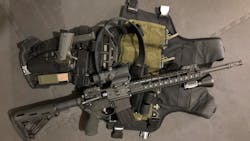Combat, Duty & EDC: What’s the Difference?
In the world of firearms and all the accessories that go with them, it’s easy to jump to some false conclusions based on the pictures generally used. For instance, some holster manufacturers use pictures of a full-size compensated handgun for off-duty and/or concealed carry. Add in the mounted optic and the seemingly mandatory flashlight, and the representation is that the average concealed carry handgun is a combat weapon system. A recent survey performed by Officer Media Group and answered by over 2,500 people revealed that the combat weapon system image is far from the truth.
Those pictures often show the handgun with three to five spare magazines along with a trauma kit, knife, some rifle magazines and body armor. Is all of that shown just to make the handgun look cool? Is the manufacturer trying to sell the holster and everything else shown is just to look “tacti-cool?”
What is realistic? It depends on the situation and circumstances. What should be carried in combat is very different from what would be carried on duty and that differs from what you would carry off-duty. We decided to examine those three different scenarios and take a look at what is commonly carried instead of what you might be lead to believe by the various marketing photos you see.
Duty use: The most common for our readership
Most officers today have to carry the handgun they’re issued. It’s more than likely a semi-auto chambered in 9mm or .40S&W—with a smattering of .45ACP and other calibers thrown in—and holds 15+ rounds in the magazine. It will likely be a striker-fired weapon or a DA/SA semi-auto. It probably has night sights and a growing number of these duty handguns have flashlights mounted to them.
That’s a fairly large package to be carrying 100% of the time on duty, but it’s a lot smaller than so many guns you see posted. Most duty handguns don’t have a threaded barrel, suppressor attached, red-dot optic, laser units in addition to light systems, etc. Most officers are carrying two spare magazines, although more is not unheard of. (NOTE: The only time you can have too much ammo is if you’re drowning or on fire.)
The duty handgun is most often carried on the gunbelt in the issued duty holster. Obviously, this is in reference to the uniformed patrol officer. Most plainclothes officers are carrying a variant of the duty handgun and are doing so in a simple pancake (or similar) holster.
In addition to the duty handgun, most officers have a long gun available as well. There is probably also a trauma kit—commonly referred to as a blowout kit or IFAK (Individual First Aid Kit) available. Almost every officer has a knife (or two) on their person along with other tools of the trade.
Off-duty carry: The second most common use
It can be amazing to see what people carry (or claim to carry) day in and day out, most especially in the summer when they claim to be concealing it all. Unless every one of these people is John Wick, constantly wearing a custom tailored suit, and walking around ready for urban combat at any moment, the B.S. flag has to be thrown on a lot of those photos.
Yes, there are some folks who walk around daily with their untucked button-down shirt covering the full-size semi-automatic handgun, equipped with a red-dot optic and a flashlight, all carried in-the-waistband (IWB) in the appendix position. As was reported in the article about our off-duty weapon survey, this is not the common happenstance. More often than not, the off-duty (and EDC) carry is smaller than the duty weapon and sports none of the “cool guy” stuff.
As a general minimum, the off-duty officer or legally armed citizen is carrying a 9mm semi-automatic (with a significant portion carrying .40S&W, .45ACP and .380ACP as well) that holds 7 to 10 rounds per magazine. They are carrying one or two spare magazines, a knife and a flashlight. Some also carry basic first-aid supplies, but a lot don’t. It’s too hard to hide or carry comfortably.
Combat duty needs
These officers need to be carrying a long gun as their primary weapon with the duty handgun as a secondary or backup gun. For the long gun, an additional number of magazines is necessary. In addition to the spare rifle magazines, spare handgun magazines are also needed. Handguns with threaded barrels for suppressor attachment might be called for. Having flashlights mounted on all weapons is mandatory and having laser-aiming devices or red-dot optics is far more common.
In addition to the weaponry, these officers need to be carrying expanded trauma kits. The limit of what is carried for first-aid trauma care should only be limited by the amount of space, weight and training for the officers.
In closing, don’t believe everything you see in photographs pimping holsters, sights, weapon finishes, etc. Those photos are meant to help sell a product and they do a good job of it. That doesn’t mean that those photos realistically depict what is carried every day, on-duty, off-duty, etc. Some common sense filters have to be applied.

Lt. Frank Borelli (ret), Editorial Director | Editorial Director
Lt. Frank Borelli is the Editorial Director for the Officer Media Group. Frank brings 20+ years of writing and editing experience in addition to 40 years of law enforcement operations, administration and training experience to the team.
Frank has had numerous books published which are available on Amazon.com, BarnesAndNoble.com, and other major retail outlets.
If you have any comments or questions, you can contact him via email at [email protected].



